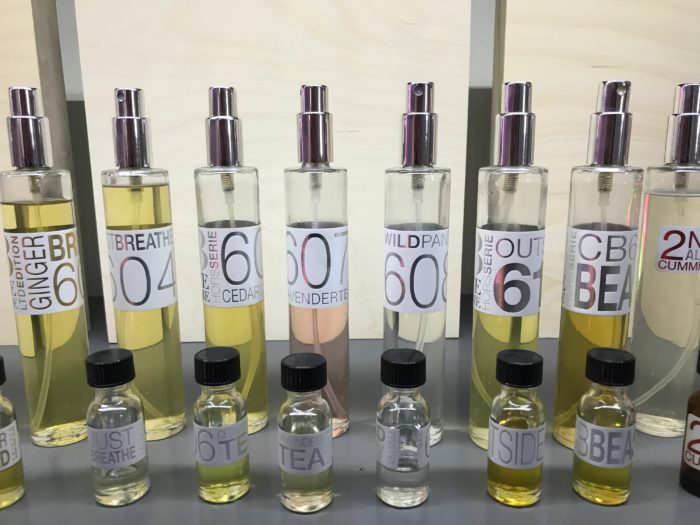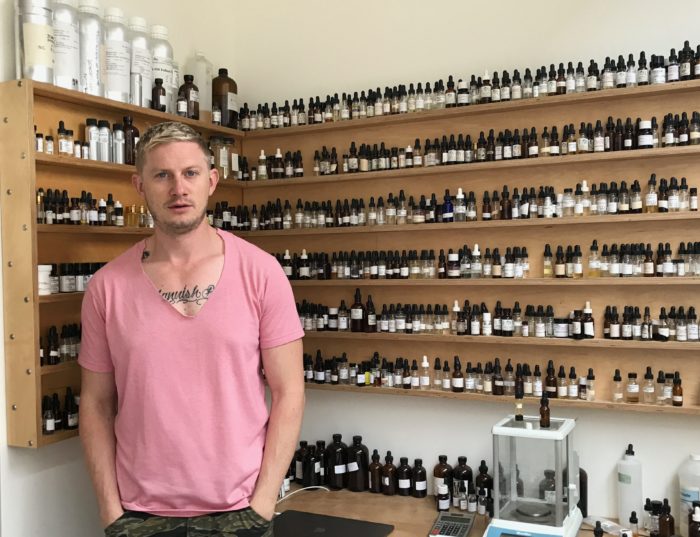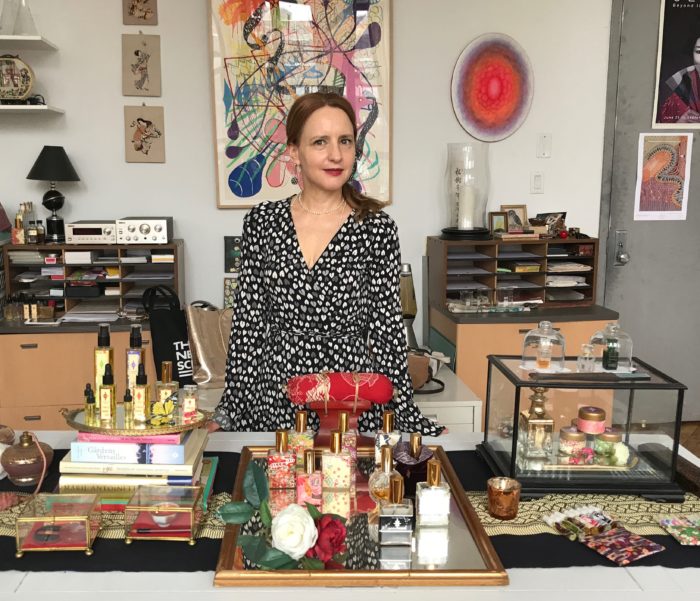Sure, it’s easy to buy your perfume at a chain drug store, but since humans have such a discriminating sense of smell, why choose on the basis of convenience? You could apply a fragrance made with real artistry–by a real fragrance artist. Many consumers are doing just that, turning away from celebrity-branded scents and fueling the growth of the niche-fragrance business.
For stellar examples, you need look no further than Brooklyn, the land of arts and crafts. Niche perfumery partakes of both. On the one hand, blending perfumes requires a practical set of skills; on the other, niche perfumers have a very precise artistic vision for each fragrance they conceptualize. They’re no strangers to other art forms: notable Brooklyn-based olfactory artists come from the realms of music, animation, fine arts and haute cuisine.
They have an enthusiastic clientele here too. “Brooklyn houses hordes of artsy types, which is exactly the kind of audience an independent perfumer is likely to garner,” Krista Miller, store manager at the Boerum Hill apothecary Twisted Lily, told me. “Many of the perfumers here in the city frequently find time to get together to discuss scent and sniff away together,” Miller added. “There’s a strong sense of camaraderie within the fragrance community.”
We spoke to several of the most notable Brooklyn-based perfumers on their art and business:
Christopher Brosius of CB I Hate Perfume
The brand name CB I Hate Perfume reflects a grudge that founder Christopher Brosius holds against the fragrance-industrial complex. “To be perfectly honest, the vast majority of the fragrances stink,” he told me. “They are full of chemicals, they are incredibly pervasive, they won’t go away, and they cause a lot of people actual distress.” His own irritation over bad perfume manifests in migraine headaches, nausea and a clenching of his throat; a complete manifesto is on his website.

An array of fragrances by Christopher Brosius at CB I Hate Perfume
Brosius rose to prominence in the 1990s, when he created fragrances inspired by earthy themes, including dirt and snow, for Demeter Fragrance Library. In 2003, he was the first perfumer to be included in a major design exhibition, the Cooper Hewitt Design Triennial. “They chose my work because the curator recognized that scent is designed,” he said. “To create a scent you have to engage in the same process that a designer goes through. You need to think about what is the intention, what it is supposed to express, and what materials are going to express in the highest possible way.”
His East Williamsburg store and atelier has a minimalistic, art-gallery vibe. His fragrances, which he makes both as concentrated oils and in lighter eaux, are divided by series, including Secret History (referencing his personal story), Reinvention (a tribute to perfume tradition), Metamorphosis (the concept of transformation) and LTD (Stand-alone Limited Editions).
While Brosius is known for such off-beat scents At the Beach, which smells a bit like Coppertone, and Beast, which reminds some of roast beef, he also pays tribute to tradition. A scent like Seven Billion Hearts, for example, reinterprets cardinal elements of historic perfumes. One of his clients owned an original bottle of Shalimar dating back to the 1920s, which inspired Brosious to explore how fragrances with a rich history changed over the decades.
“Once upon a time perfumes were made from natural ingredients, because those were all that were available,” he said. “Market demands prompted the sale of ingredients that were cheap. Little by little, the real was replaced by cheap and synthetic, and it changed the character of classic fragrances that had been around for 100 years.”
Brosius’s most recent release, On a Clear Day You Can See Forever, inspired by a bouquet of spring flowers he loved as a child, was in Spring 2016. He has not released any new fragrances since then, because he abhors being tied to a predictable release cycle. “I prefer to release things when the idea is completely clear and the scent I design matches that and expresses that perfectly,” he said. “For me, it’s just more like releasing a music album. The artist knows that the album is finished and ready to go.”
Stephen Dirkes of Euphorium Brooklyn
If you ask Stephen Dirkes what prompted him to found Greenpoint-based Euphorium Brooklyn after a lifetime spent being a filmmaker, a stop-motion animator and a classically trained composer, you will get an answer that begins with his studies in perfume materials inspired by time spent living in Indonesia (on a scholarship to study Gamelan music). And the story keeps unspooling from there.
“[Euphorium] was very consciously a way, within an American 21st-century context, to do my little Richard Wagner,” he said. He was referring to the Wagnerian concept of Gesamtkunstwerk, a work using several art forms. In fact, for each Euphorium fragrance, he wrote a story, composed music, and created a film.
Euphorium is built around such story-telling. It portrays itself as a revival of Euphorium Bile Works, a Victorian-Era perfumery owned by three fictional aesthetes: Christian Rosenkreuz, a German scientist obsessed with bears; Etienne Chevreuil, an effete Frenchman; and Rudolph Komodo, a snake-oil salesman from Indonesia. Dirkes envisions each of the eight fragrances that compose the collection as being part of the life story of each of the three gentlemen.
Rosenkreuz’s perfumes have a Germanic undertone, and are centered around the theme of the woods and the bear, who snatched and killed his foundling daughter. The fragrance called Wald has deep, piney accords reminiscent of the Black Forest, whereas 100 Tweeds references the jacket his daughter wore when she met her demise.
One of the videos that perfumer Dirkes created to accompany a fragrance (Video via Euphorium Brooklyn)
The character Chevreuil’s sophistication emerges in his creations. Petales, for example, is a dark flower bouquet. “I tried to go the darkest possible,” said Dirkes. “There is this molecule, Indole, that is present in orchids and in pubic hair.”
Komodo, the Indonesian salesman, pays tribute to Vetiver, a native plant of his country, in the fragrance called Usar. “In terms of Komodo’s story, I wanted it to feel extra bitter, almost as a medicinal drug thing,” said Dirkes.
Dirkes’ latest effort, called Butterfly, did not start out as a story, but as an environmental study of the vegetation and migrating butterflies along Newtown Creek, the grimy industrial passage between Brooklyn and Queens. “To some extent, it was an effort for me to work with ideas I am not a particular fan of,” he said, including the scents of bright flowers, water and mint. Of the latter, he said, “It’s a bane for most perfumers. So many different kinds of mint skew to mouthwash, toothpaste or shampoo.” Dirkes is planning to turn Butterfly into a ballet, and is looking to Japanese culture for this next creations.
David Seth Moltz, D.S. & Durga
In D.S. & Durga’s pristine atelier-boutique in Bedford-Stuyvesant, co-founder David Moltz’s desk is surrounded by rows and rows of shelves teeming with vials, the building blocks for his creations. They are divided by group and alphabetically: there are musks, woods, fruits, flowers, spices, herbs and aldehydes. A musician by trade, Moltz founded the perfumery in 2007 with his wife, Kavi, an architect. D.S. & Durga is a reference to their respective nicknames.
“I just got down and dirty in the process,” he recalled about his beginnings. “I got as many materials as possible. I started with outdated manuscripts. There would be recipes for old things, or what herbs do, and how certain things work together. Once you got to the synthetics, you start to isolate molecules away from themselves. You can make a building block of a rose with five chemicals.” He also took private lessons in organic chemistry, which he likened to learning how to build a guitar.

David Seth Moltz, co-founder of D.S. & Durga, with some of his raw materials
What he was writing about in music, he was able to translate into fragrance, but in a more universal way. “There’s no hiding behind my voice, and what my obvious influences are in music,” he said. “In perfume, you might be able to make it a little bit more quiet.”
His fragrances reflect his interest in the lines between our world and the other world, whether it’s spiritual or mythological. “I’m fascinated by a collective unconscious, where the mythology in my head rubs against the mythology in your head, and everyone else’s,” he said. In the fragrance White Peacock Lily, a personal favorite of his, “A lone peacock floats over cream lilies, oleander, and a sea of alabaster violet.” Pre-Industrial Americana is tapped frequently too: there is the herbal Cowboy Grass, the woody Bowmakers and the smoky Mississippi Medicine.
Their namesake fragrance Durga is a rich tuberose scent that Moltz had been tinkering with for five years before getting the formula right. The raw materials ended up costing four times more than expected, however, so the initial batch consists of only 400 bottles. It’s dedicated to Kavi, who has a fond childhood memory of the tuberose flowers her uncle placed near her bed. “[The fragrance] Durga means this is us and this is the ultimate thing we can do,” said Moltz.
The perfumer acknowledges that learning the business was more challenging than he expected. “Perfume is a very top-down industry; there is strict regulation. It takes a lot of esoteric knowledge in order to understand how to do it.”
Maria McElroy of Aroma M
The fragrances of Aroma M, which are carried in department stores from Manhattan to Shanghai, offer a passionate and refined love letter to Japan. In 1995, painter and aromatherapist Maria McElroy had just come back to the U.S. after seven years in Japan studying Zen Buddhism, kodo (the art of incense ceremony) and ikebana (the art of flower arranging) and had no clear idea of what she was going to do next. So, she started bottling “some things” in her house.
“Next thing I knew, I had a business. It was not thought out,” she said while whisking matcha in her atelier in Bushwick. Since that conversation, she has decamped to Hoboken, but wherever she goes, McElroy is spiritually in Japan. “The Japanese say I am more Japanese than they actually are,” said McElroy, who is married to a Japanese sushi chef. “I just find Japan incredibly beautiful. I love the arts, the lifestyle. It’s a beautiful way to live, the way they embrace nature and the way it ties into everything.”

Maria McElroy, who brings a love of all things Japan to her line, Aroma M
Ingredients such as green tea, hinoki wood and incense are featured heavily in her creations, which come all wrapped in yuzen paper hailing directly from Kyoto. Her first group of fragrances, O-Cha (green tea), Hana-Cha (flower tea) and Nobara-Cha (wildrose tea), are an homage to tea itself. “I love the ritual of it, I love the lore, the history.”
The Color Series (Rouge, Noire and Blanche) stems from her background as a painter. “I often imagine fragrances with color, and that’s the beginning of how they all started,” she said. Rouge, a warm fragrance, has no floral notes at all, which is unusual in the fragrance world. Noire and Blanche are envisioned as the yin and the yang: noire is a quintessentially oriental fragrance, redolent of spices, vanilla, tonka bean and amber, while Blanche is a white-flower bouquet. “I wanted to make something that wasn’t boring, because most white flowers are kind of boring,” McElroy said. “It has lychee in it, which gives it that kind of crispness, and brings it back to Asia and Japan.”
The current star of her line is Vanilla Hinoki, which blends smoky vanilla from Morocco with hinoki, a variety of Japanese cypress whose wood is used to make traditional bathtubs. “I love bathing, I love the whole bath ritual, but I kind of wanted to translate that feeling of when you go into that hot spring,” she said.
McElroy is equally skilled at creating non Japanese-inspired fragrances. Voluptuous Nostalgia is a tribute to the glamorous Roman holidays of yore, and House of Cherry Bomb is a full-fledged parallel line that she created alongside fellow perfumer Alexis Karl. “We are just two girls having fun, listening to the Cure, eating cookies,” is how she describes the partnership. One of the scents, Pink Haze, is a tribute to the borough of Brooklyn. It contains notes of early-summer blossoms, concrete, asphalt and the haze of urban sunsets.